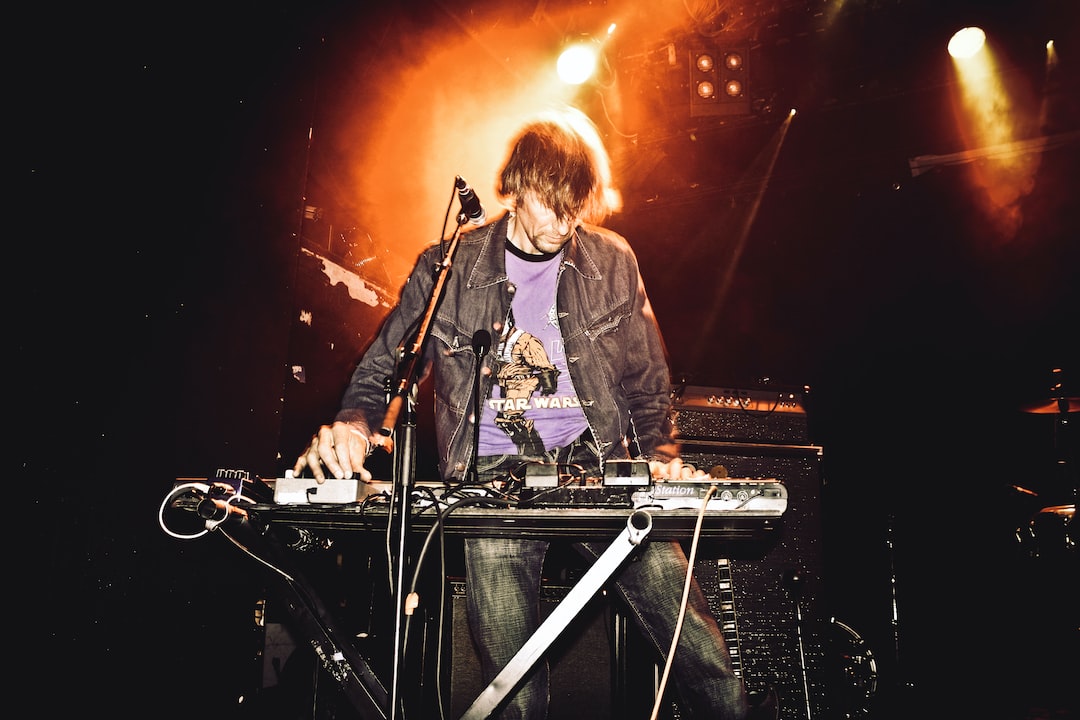Support our educational content for free when you purchase through links on our site. Learn more
What is Synth-Pop Best Described As? [2024]

Have you ever found yourself tapping your foot to an infectious electronic beat? Or singing along to catchy melodies that seem to transport you to another era? If so, you may have been listening to synth-pop without even realizing it. Synth-pop, short for synthesizer pop, is a music genre that emerged in the late 1970s and quickly became a cultural phenomenon. In this article, we will explore what synth-pop is best described as, its characteristics, history, influence, and much more. So, let’s dive in and discover the captivating world of synth-pop!
Table of Contents
- Quick Answer
- Quick Tips and Facts
- Background: The Rise of Synth-Pop
- Characteristics: The Sound of Synth-Pop
- Evolution and Influence: From Post-Punk to Mainstream
- Artists: Pioneers and Icons of Synth-Pop
- Criticism and Controversy: The Dark Side of Synth-Pop
- FAQ
- Conclusion
- Recommended Links
- Reference Links
Quick Answer
Synth-pop can best be described as a music genre that emerged in the late 1970s, characterized by its primary use of synthesizers, drum machines, and sequencers. It combines electronic sounds with catchy melodies and often features a futuristic or nostalgic aesthetic. Synth-pop is known for its infectious beats, melodic hooks, and the use of technology to create and reproduce music.
Shopping Links: CHECK PRICE on Synth-Pop Music | Shop Synth-Pop on Amazon | Shop Synth-Pop on Walmart | Shop Synth-Pop on Etsy
Quick Tips and Facts
- Synth-pop emerged in the late 1970s as part of the new wave movement and gained popularity in the 1980s.
- It is characterized by its primary use of synthesizers, drum machines, and sequencers.
- Synth-pop often features catchy melodies, electronic beats, and a futuristic or nostalgic aesthetic.
- The genre has influenced a wide range of artists and musical styles, from pop to electronic dance music.
- Some iconic synth-pop artists include Depeche Mode, New Order, Pet Shop Boys, and Yazoo.
Background: The Rise of Synth-Pop

To understand what synth-pop is best described as, we need to delve into its background and origins. Synth-pop emerged in the late 1970s as a response to the punk and post-punk movements. It was a time of musical experimentation and technological advancements, with synthesizers becoming more accessible and affordable.
The genre found its roots in both Japan and the United Kingdom, with bands like Yellow Magic Orchestra and The Human League pioneering the use of synthesizers as the dominant musical instrument. These early synth-pop pioneers embraced the new technology and used it to create unique sounds that captured the imagination of listeners.
Synth-pop quickly gained popularity in the 1980s, thanks to its infectious beats, melodic hooks, and the rise of music videos on channels like MTV. The genre’s futuristic and often nostalgic aesthetic resonated with audiences, and synth-pop became a cultural phenomenon.
Characteristics: The Sound of Synth-Pop
Synth-pop is characterized by its distinctive sound, which is achieved through the use of synthesizers, drum machines, and sequencers. These electronic instruments allow artists to create a wide range of sounds and textures, from lush pads and soaring leads to pulsating basslines and rhythmic patterns.
One of the defining characteristics of synth-pop is its emphasis on catchy melodies. The genre often features memorable hooks that get stuck in your head and make you want to dance. These melodies are typically accompanied by electronic beats, which give the music a driving and energetic feel.
Another notable aspect of synth-pop is its use of technology. Many synth-pop musicians had limited musical skills but relied on the technology to produce or reproduce the music. This allowed for experimentation and innovation, pushing the boundaries of what was possible in popular music.
Evolution and Influence: From Post-Punk to Mainstream
Synth-pop has come a long way since its humble beginnings in the late 1970s. In its early years, the genre was often associated with the underground and alternative music scenes. However, as the 1980s progressed, synth-pop began to infiltrate the mainstream.
The introduction of dance beats and more conventional rock instrumentation in the 1980s made the music warmer and catchier, bringing it within the conventions of three-minute pop songs. Bands like Depeche Mode, New Order, and Pet Shop Boys achieved commercial success with their synth-pop sound, reaching the top of the charts and captivating audiences worldwide.
Synth-pop’s influence extends far beyond the 1980s. The genre has inspired countless artists and genres, from electronic dance music to indie pop. Its legacy can be heard in the music of contemporary artists like The Weeknd, CHVRCHES, and Robyn, who continue to push the boundaries of electronic pop music.
Artists: Pioneers and Icons of Synth-Pop
Synth-pop has been shaped by a diverse range of artists who have left an indelible mark on the genre. Here are some of the pioneers and icons of synth-pop:
-
Depeche Mode: Known for their dark and brooding sound, Depeche Mode became one of the most successful synth-pop bands of all time. Hits like “Just Can’t Get Enough” and “Enjoy the Silence” showcase their unique blend of electronic and rock elements.
-
New Order: Formed from the ashes of Joy Division, New Order combined post-punk sensibilities with electronic experimentation. Their iconic track “Blue Monday” is often cited as one of the greatest synth-pop songs ever recorded.
-
Pet Shop Boys: With their flamboyant style and infectious pop hooks, Pet Shop Boys became synonymous with synth-pop in the 1980s. Songs like “West End Girls” and “It’s a Sin” propelled them to international stardom.
-
Yazoo: Comprised of Vince Clarke (formerly of Depeche Mode) and Alison Moyet, Yazoo created a unique blend of synth-pop and soul. Their hits “Only You” and “Don’t Go” remain timeless classics.
These are just a few examples of the many artists who have contributed to the rich tapestry of synth-pop. Each artist brings their own unique style and sound, adding to the genre’s diversity and appeal.
Criticism and Controversy: The Dark Side of Synth-Pop
While synth-pop has enjoyed widespread popularity and critical acclaim, it has not been without its share of criticism and controversy. Some critics argue that the genre lacks authenticity and relies too heavily on technology, with many synth-pop musicians having limited musical skills.
Others have criticized synth-pop for its often glossy and commercial sound, accusing it of being too focused on image and style rather than substance. However, proponents of the genre argue that synth-pop’s emphasis on catchy melodies and electronic sounds is precisely what makes it so appealing and enduring.
Like any genre of music, synth-pop has its detractors and controversies. However, its impact and influence cannot be denied, and it continues to captivate audiences around the world.
FAQ

What is synth-pop best described as?
Synth-pop can best be described as a music genre that emerged in the late 1970s, characterized by its primary use of synthesizers, drum machines, and sequencers. It combines electronic sounds with catchy melodies and often features a futuristic or nostalgic aesthetic.
Read more about “What is synth-pop best described as?”
What are the characteristics of synth-pop?
The characteristics of synth-pop include its primary use of synthesizers, drum machines, and sequencers. It is known for its catchy melodies, electronic beats, and the use of technology to create and reproduce music.
Read more about “Modern Synth Pop Songs 2024: The Ultimate Playlist and Guide”
What does synth-pop sound like?
Synth-pop sounds like a fusion of electronic and pop music. It often features infectious beats, melodic hooks, and a blend of futuristic and nostalgic sounds. The genre can range from upbeat and danceable to introspective and atmospheric.
Read more about “… What is considered synth-pop? A Comprehensive Guide”
What is synth-pop a subgenre of?
Synth-pop is a subgenre of electronic music and is often associated with the broader new wave movement of the late 1970s and early 1980s. It has also influenced other genres such as electronic dance music and indie pop.
Conclusion

In conclusion, synth-pop is best described as a captivating music genre that emerged in the late 1970s. It combines electronic sounds with catchy melodies, creating a unique and infectious sound that has captivated audiences for decades. Synth-pop’s primary use of synthesizers, drum machines, and sequencers sets it apart from other genres, allowing for endless possibilities in sound creation. From its humble beginnings to its mainstream success, synth-pop has left an indelible mark on the music industry and continues to inspire artists to this day.
If you’re looking to explore the world of synth-pop further, check out our Iconic Synth Pop Songs and 80s Synth Pop categories for a curated selection of must-listen tracks. And if you want to dive into the modern synth-pop scene, don’t miss our Modern Synth Pop category for the latest releases and emerging artists. Happy listening!
Recommended Links
- CHECK PRICE on Synth-Pop Music | Shop Synth-Pop on Amazon | Shop Synth-Pop on Walmart | Shop Synth-Pop on Etsy
- Iconic Synth Pop Songs
- 80s Synth Pop
- Modern Synth Pop
- New Wave music
- What Makes a Song Synth-Pop? 2024





